|
This
picture gallery summarizes the molluscs found on top of beachrock at Playa
Estacion, Puerto Penasco, Sonora, Mexico.
It
should be used to complete lab activity 9.2.
|
Arca
pacifica
|
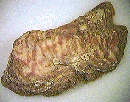 |
"Ark
shell"
| Phylum |
Mollusca |
| Class |
Pelecypoda |
| Order |
Arcoida |
| Family |
Arcidae |
|
| Morphology |
Commonly
3 - 4 inches, dull white, with a toothed hinge extending the
length of the shell. Irregular ribbing with V-shaped brown bands.
The live shell is often covered with a brown, fibrous frowth
and is found anchored to a rock by its byssus threads. |
| Feeding |
Filter feeders |
| Defense |
Can close its
shell to conserve moisture. May also tightly close shell if
disturbed. |
| Reproduction |
Separate sexes
and spawning |
| Habitat |
Intertidally
to deep water. Specifically: pavement surface |
| Distribution |
Scammon's Lagoon,
Baja California, and throughout the Gulf, south to Peru. |
| Other |
|
|
|
Chama
mexicana
|
|
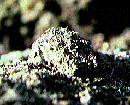
|
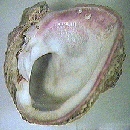 |
"Mexican
jewel box"
| Phylum |
Mollusca |
| Class |
Pelecypoda |
| Order |
Veneroidea |
| Family |
Chamidae |
|
|
| Morphology |
Light
brown to red shell with two rows of large spines and many smaller
ones that break off with age. The shell is variable in shape
and has a pinkish interior. The lower valve is cemented to the
rock surface. Up to 3.5 inches long. |
| Feeding |
Filter feeding |
| Defense |
Difficult to
dislodge or pry open |
| Reproduction |
Separate sexes
and spawning |
| Habitat |
On intertidal
rocks |
| Distribution |
Gulf of California |
| Other |
Shells serve
as a habitat for various species of boring orgainisms. |
|
|
Modiolus
capax
|
|

|
 |
"Horse
mussel"
| Phylum |
Mollusca |
| Class |
Pelecypoda |
| Order |
Mytiloidea |
| Family |
Mytilidae |
|
|
| Morphology |
A
swollen orange-brown shell covered with a "beard"
of serrated brown hairs distinguishes this mussel from any other.
The shell lacks any strong sculpture. |
| Feeding |
Filter feeders. |
| Defense |
The serrated
hairs provide camoflouge for the mussel as well as a place for
other animals to grow. Can close its shell to conseve moisture
- may also tightly close shell if disturbed. |
| Reproduction |
Separate sexes
and synchronous spawning |
| Habitat |
Intertidally
on rocky substrate.Particularly in crevices and cavities in
rocks and reefs, where it can avoid the full impact of the surf. |
| Distribution |
Northern California
to Peru and throughout the Gulf of California. |
| Other |
|
|
|
Acanthina
angelica
|
|

|
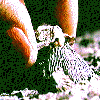 |
"Unicorn
shell"
| Phylum |
Mollusca |
| Class |
Gastropoda |
| Order |
Neogastropoda |
| Family |
Thaididae |
|
|
| Morphology |
Dull
gray, high spire with large nodes below the suture; large spine
on outer aperture, purplish-brown to glossy white interior. |
| Feeding |
Often occur
in large clumps while feeding on barnacles. Apertural spine
possibly used to pry open the opercular plates of acorn barnacles |
| Defense |
Thick shell |
| Reproduction |
Fertilization
is internal - females deposit egg capsules under rocks. |
| Habitat |
On rocks in
mid to high intertidal zone on or near barnacles. |
| Distribution |
Gulf of California,
Puerto Penasco, Sonora, Mexico. |
| Other |
|
|
|
Muricanthus
nigritis
|
|
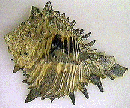
|
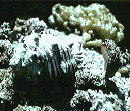 |
"Black
murex"
| Phylum |
Mollusca |
| Class |
Gastropoda |
| Order |
Neogastropoda |
| Family |
Muricidae |
|
|
| Morphology |
off
white shell with dark brown to black spines and a siphonal canal
that extends from the anterior of the aperature. Up to six inches
long. |
| Feeding |
Carnivorous
on bivalves and other molluscs |
| Defense |
Thick shell |
| Reproduction |
|
| Habitat |
On rocks and
mud flats in the lower intertidal and shallow subtidal. |
| Distribution |
Gulf of California |
| Other |
|
|
|








